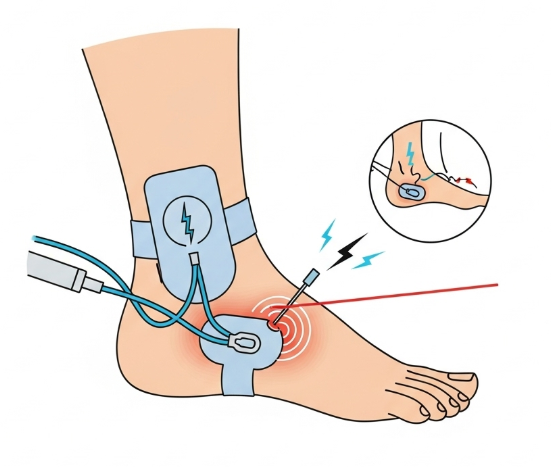Ankle sprains are a common setback, impacting individuals from all walks of life, from athletes striving for peak
performance to everyday people navigating their daily routines. The pain, swelling, and restricted movement can
significantly disrupt your life, making even simple tasks challenging. Fortunately, advancements in physiotherapy
offer effective solutions. Interferential Therapy (IFT) is one such modality, harnessing the power of electrotherapy
to promote faster healing and provide pain relief. This blog post delves into how to maximize the benefits of IFT for
ankle sprains, providing insights into its application within the scope of physiotherapy practice.
Understanding Interferential Therapy (IFT) for Ankle Sprains
IFT is a valuable tool in physiotherapy, utilizing medium-frequency electrical currents to stimulate tissues deep
within the injured area. This non-invasive technique employs two alternating currents that intersect, creating an
interference pattern at the site of the ankle sprain. This interference generates a low-frequency current within the
tissue, which is believed to stimulate nerve fibers, ease pain, and promote healing.
The primary goal of IFT is to deliver therapeutic effects to the deeper tissues surrounding the ankle joint.
By targeting these tissues, IFT can help to modulate pain signals, decrease inflammation, and encourage
the body's natural healing processes. The low-frequency current generated by IFT interacts with nerve fibers,
helping to interrupt pain signals sent to the brain.
Unlocking Maximum Pain Relief: IFT Benefits for Ankle Sprains
One of the most significant benefits of IFT is its ability to provide effective pain relief. The electrical stimulation
actively disrupts pain signals to the brain, offering a temporary reduction in discomfort. This can be particularly
helpful in the acute phase of an ankle sprain when pain levels are often at their highest.
Beyond pain relief, IFT effectively combats swelling (edema) around the ankle joint. The electrical stimulation
can promote lymphatic drainage and improve local circulation, which aids in the removal of excess fluid from
the injured area. This reduction in swelling can further contribute to pain relief and improved range of motion.
Furthermore, IFT can stimulate muscle contractions, which can help to prevent muscle atrophy and maintain
strength during the recovery process. IFT may be particularly beneficial for athletes with ankle sprains, as studies
show how noninvasive interactive neurostimulation therapy improves short-term recovery in athletes.
Fine-Tuning IFT: Understanding Parameters for Optimal
Ankle Sprain Results
The effectiveness of IFT also depends on the appropriate selection of treatment parameters, including frequency,
intensity, and duration. These parameters should be carefully adjusted based on the patient's individual needs,
tolerance, and the stage of healing. A physiotherapist will use their expertise to determine the optimal settings
for each patient.
For example, in the early stages of an ankle sprain, a lower intensity may be used to minimize discomfort, while
a higher frequency may be used to target pain relief. As the injury heals, the parameters may be adjusted to
promote muscle stimulation and tissue repair. It's important to communicate openly with your physiotherapist
about your comfort levels and any sensations you experience during the treatment. The physiotherapist may also
adjust the treatment duration based on the patient's response and the severity of the injury.
IFT and RICE: A Synergistic Approach to Ankle Sprain Recovery
IFT is often used in conjunction with other standard treatments for ankle sprains, such as the RICE protocol (Rest,
Ice, Compression, Elevation). This combined approach can provide a synergistic effect, accelerating the healing
process and improving outcomes. RICE helps to manage the initial inflammation and pain, while IFT can provide
deeper tissue stimulation and pain relief.
For instance, applying ice packs can help to reduce swelling and numb the area, while compression bandages can
provide support and stability. Elevation helps to further reduce swelling by promoting fluid drainage.
Tracking Progress, Tailoring Treatment: Adapting IFT for Ankle
Sprain Recovery
Regular reassessment of the patient's progress is necessary to modify the treatment plan as needed. A
physiotherapist will monitor the patient's pain levels, swelling, range of motion, and functional abilities to determine
how well they are responding to IFT. Based on this assessment, the treatment parameters may be adjusted, or
other interventions may be added to the plan.
For example, if a patient is not experiencing significant pain relief with IFT, the frequency or intensity may be
increased. If they are having difficulty regaining range of motion, specific exercises may be prescribed to address
this issue. This ongoing monitoring and adaptation ensures that the treatment plan remains effective and tailored
to the patient's evolving needs. It's also important to consider other potential causes of persistent ankle pain, such
as nerve damage, and the need for a thorough assessment.
Conclusion
Interferential Therapy can be a valuable tool in the physiotherapy management of ankle sprains. By providing pain
relief, reducing swelling, and stimulating tissue healing, IFT can help patients recover more quickly and return to
their normal activities. Remember, IFT should always be administered by a qualified physiotherapist as part of a
comprehensive rehabilitation program that may include exercises, manual therapy, and other modalities.
If you're experiencing an ankle sprain, consult with a physiotherapist to determine if IFT is right for you. They
can assess your condition, develop a personalized treatment plan, and guide you through the recovery process.
Transforming physiotherapy, one patient at a time.
